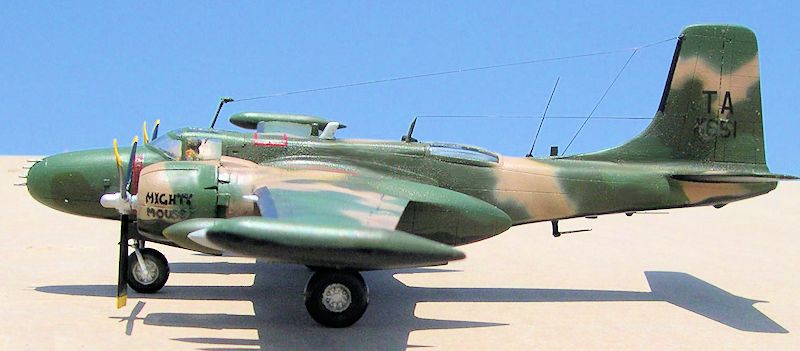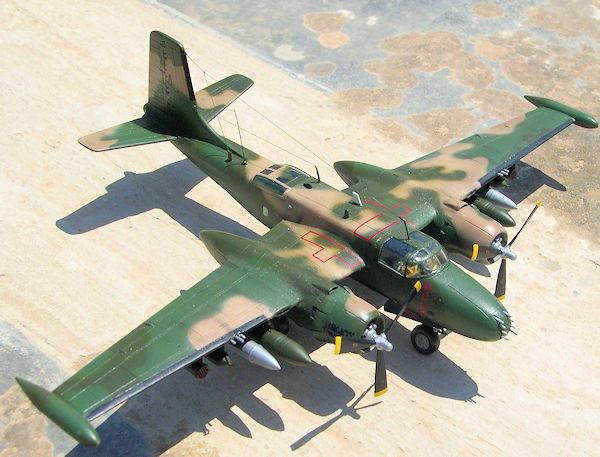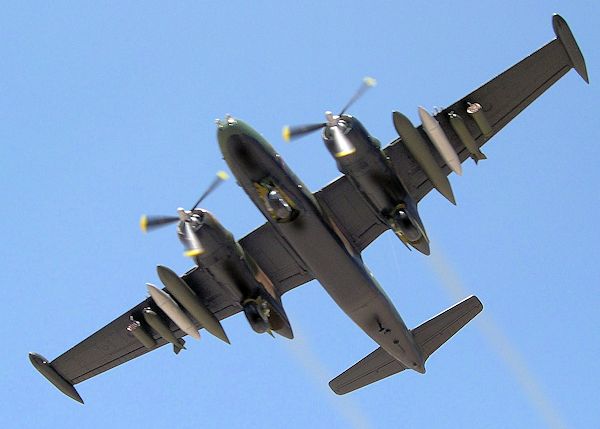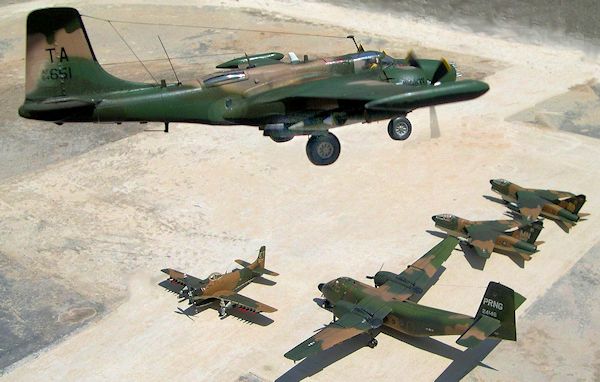
Italeri 1/72 B-26K Counter Invader
| KIT #: | 1249 |
| PRICE: | 15.75 euros |
| DECALS: | Four options |
| REVIEWER: | Carmel J. Attard |
| NOTES: |

| HISTORY |
The A-26 medium bomber was developed by the USA during WWII.
Douglas built and delivered over 2,500 A-26s between the type first
flight in July 1942 and delivery of the last airframe in August 1945.
Introduction into service was quite slow and it was not until autumn1944 that
the A-26 saw action in Europe, flying over 11,000 sorties before the end of the
conflict.
 cold war era
where it has thrived in such missions to attack enemies in jungle cover with
adequate payloads, target acquisition and adequate endurance during such
missions.
cold war era
where it has thrived in such missions to attack enemies in jungle cover with
adequate payloads, target acquisition and adequate endurance during such
missions.
Alterations
were made do to keep aircraft in service and eventually emerged the YB-26K
counter Invader prototype. The variety of features added comprised internal
upgrades and refinements that enhanced operational effectiveness. This included
a new broad chord rudder with an additional trim tab; redesign the wing so that
it is strong enough to carry close to 8,000 lbs of ordnance on eight new pylons
besides the 4,000 Lb payload in the bomb bay; additional fuel in wing tip tanks;
more powerful R-2800-103W engines that drove a broader fully reversible square
tipped propeller blades and also revised cowlings on some of the B-26K with
carburettor inlets moved further aft. The nose wheel steering also had larger
wheels and brakes. De-icing boots added to wings and tail fin, gun turrets
removed and faired over and new radio and update antenna equipment installed.
The A-26K continued to serve in anti-guerrilla operations until 1970.
| THE KIT |

Decals are provided for three Vietnam three-tone camouflage A-26Ks that were
attached to 609th SOS Thailand based between 1966-70 and another two
A-26K that were operated by the Congolese AF units during 1966 and 1967. The
latter two are finished in field green upper surfaces and light ghost grey lower
surfaces. Fancy nose or engine cowling markings decorates four of the machines.
| CONSTRUCTION |
I was using SAC metal wheel legs; the nose wheel leg was fixed in place before
the fuselage was closed. Instruments are given in decal form, which I applied
while the fuselage halves were still separate. The kit
 provides a
well-detailed bomb bay complete with a full bomb load. I elected to close the
bomb doors and there was no scope in detailing an area that was to be hidden.
The solid nose was fitted at a final stage where it also served as a place to
add lead weight in order that the kit will in the end balance on nose wheel. I
found that sealing the lead in a coat of white glue will isolate any oxide which
may form in time from lodging on clear cockpit canopy interior or fall under the
nose gear.
provides a
well-detailed bomb bay complete with a full bomb load. I elected to close the
bomb doors and there was no scope in detailing an area that was to be hidden.
The solid nose was fitted at a final stage where it also served as a place to
add lead weight in order that the kit will in the end balance on nose wheel. I
found that sealing the lead in a coat of white glue will isolate any oxide which
may form in time from lodging on clear cockpit canopy interior or fall under the
nose gear.
Although I found the kit to be a first class one at this scale, more recently
after market kit items have been issued to further enhance detail to certain
parts of the kit. These detail sets pertain to the radial engine and cowlings on
one part and much stronger metal undercarriage on another, The resin engine
detail set is released by Pavla Models which comes as set U72-72 and was
purposely released for the Italeri kit of the B-26K. This I have used with no
difficulty.
Other detail I added consisted of antennas and aerials attached to several spots
on the fuselage. These were HF antenna, a loop antenna, UHF antenna, VHF-101
antenna, ADF SENSE antenna, localizer antenna, a distance antenna and RC-44AM
antenna.
| COLORS & MARKINGS |

In brief this was an enjoyable build and adding a sturdy undercarriage allowed me to make mock touch and goes with all the fun without risk of breaking the wheel legs.
August 2013
If you would like your product reviewed fairly and fairly quickly, please contact the editor or see other details in the Note to Contributors.